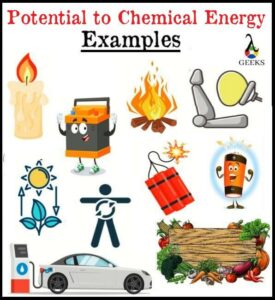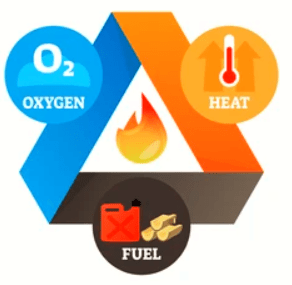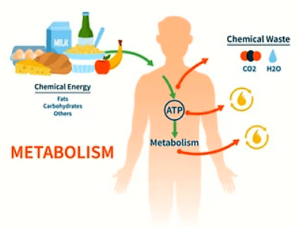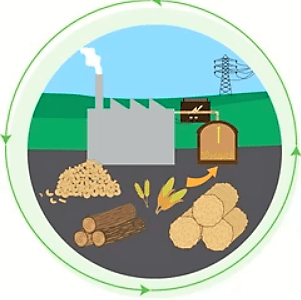The conversion from potential to chemical energy depicts how stationery molecules form chemical bonds. The article discusses such an example of potential energy to chemical energy, which is listed below:
Read more about Example of Potential Energy to Light Energy.
Battery
It operates on the electrochemical principle where energy is converted from electric to chemical and vice versa. The battery holds the electric potential energy in a chemical state within its stationary particles during charging. In contrast, the chemical reaction delivers electric energy during the discharging.
That means chemical energy has both forms. i.e., potential energy and kinetic energy. When the energy is held in the chemical bonds of stationary particles, it is chemical potential energy.
The energy is released after particle breaking bonds when it reacts with other particles; it is transformed into chemical kinetic energy, which causes work through particle movement.
Read more about Example Potential Energy to Kinetic Energy

Electrolyte Cell
It encloses cathode and anode as electrodes dissolved by a chemical solution termed electrolyte. On incoming electrical energy, an electrolysis process decays the chemical compounds at electrodes which induces a non-spontaneous chemical redox reaction, delivering the chemical energy in the cell.
The conversion from electrical to chemical energy occurs due to oxidation and reduction of chemical reactions at both electrodes. Unlike surfaces, a chemical reaction happens between the two electrodes. That’s why the unlike substances have chemical energy because of the electrostatic attraction between their chemical bonds.

Read more about Electrostatic Charge.
Coal and Wood
The combustion process breaks the bonds between molecules that store the chemical potential energy within the surface. The broken bonds release the energy so that stationary particles react to surrounding air molecules to construct another chemical element.
When heat energy is provided to the coal or wood that contains Methane CH4, a natural gas, it reacts to oxygen O2, discharging chemical energy to create light and heat energy as a fire; and then assembling new element as carbon dioxide CO2, water H2O and ashes ΔH.
Like coal or wood, each chemical compound has potential energy held into its chemical bonds. When any contact or non-contact force functions on such compounds, it damages their chemical bonds. The chemical energy is radiated in heat energy, i.e., either exothermic or endothermic.
Candle Wax
It is a Paraffin Wax C25H52 that contains the chemical potential energy. When we ignite the candle, it supplies heat energy to wax from its wick. The paraffin wax melted to expose to the air molecule O2 and create carbon dioxide CO2 and water molecule H20.
The reactions due to burning provide heat energy and light energy through a wick.
Air Bag
Have you known the airbag that protects the driver during an accident is activated when chemical reactions happen within the bag? When a car unexpectedly deaccelerated, the sensor in the system turned on the electrical panel, which ignited the Sodium Azide NaN3 inside the bag.
The chemical reaction yields the nitrogen gas, filling the bag at a highly rapid rate.

(credit: shutterstock)
Petroleum
It comprises both crude oil and natural gas with molecules of hydrogen and carbon that keep the potential energy chemically into any vehicle’s tank. The combustion of petroleum or gasoline creates chemical energy, composing different chemical elements.
The newly formed Isooctane C8H18 and oxygen O2 are subjected to the engine, burning steadily to do the tasks.
- Some of its transformed chemical kinetic energy enables the vehicle to move on the road.
- Some of the potential chemical energy is transformed into heat energy as the vehicle’s engine becomes hot.

(credit: shutterstock)
Dynamite or Explosives
It contains Nitro-glycerine C3H5N3O9, a various unstable chemical element that shows it has the potential energy to explode. It is exposed to the air O2 molecule when the dynamite ignites The reactions provoke the dynamite to blast with the release of immense amounts of nitrogen and tremendous heat and sound energy.

(credit : shutterstock)
Firecrackers also operate on an equivalent principle to convert potential energy to chemical energy.
Read more about Examples of Potential Energy to Sound Energy.
Food
Eating food provides energy to the body. That indicates that the food contains its energy, energizing the human body. When we consume it, our body organ combines the food with enzymes and acids in the stomach.
The chemical reaction remakes the potential energy in carbohydrates into Glucose C6H12O6, which is then discharged into the bloodstream, energizing our body.

(credit: shutterstock)
Cellular Respiration
It utilizes the energy to survive, reproduce, react to stimuli, and drive biological processes. Within the human body, the atoms and molecules were structured together into chemical bonds to hold the chemical potential energy in the form of glucose.
The stored chemical energy into molecules is transformed into chemical kinetic energy, allowing the human body to move and do the work. The process of spreading the energy into your body cell is called ‘Cellular Respiration’.

(credit: shutterstock)
Photosynthesis
When the sun lights on the plants, it changes solar energy to chemical energy. The process is called ‘photosynthesis’ which involves the chemical reaction between carbon dioxide and water molecules in solar energy to create glucose and oxygen.

(credit: shutterstock)
That’s why the plant soaks carbon dioxide and emits oxygen during photosynthesis. In comparison, photosynthesis discharges more chemical energy than the energy needed to start the chemical reactions.
Biomass
Using chemical agents, one can convert the biomass materials into biodiesel as a liquid fuel. It involves the chemical reaction between glucose and the air molecule O2. The chemical reaction transforms the stored potential energy into heat energy by comprising carbon dioxide and a water molecule.

- Work Units: 19 Important Factors Related To It
- Types of Forces : 9 Important Facts You Should Know
- What is Relative Motion : Examples, Exhaustive Concepts, Problems, FAQs
- Inclined Plane: 7 Important Facts You Should Know
- 17 Examples Of Sliding Friction
- Rolling Friction: 15 Important Factors Related To It
Also Read:
- Example of kinetic to sound energy
- How to find energy utilization in sustainable architecture
- How to find internal energy
- How to find energy in a rotating reference frame
- Why is energy essential in future technology innovations
- How to increase electrical energy safety in home wiring systems
- Stored energy examples
- Nuclear energy uses
- Is static electricity energy
- Where to find mechanical energy

Hello, I’m Manish Naik completed my MSc Physics with Solid-State Electronics as a specialization. I have three years of experience in Article Writing on Physics subject. Writing, which aimed to provide accurate information to all readers, from beginners and experts.
In my leisure time, I love to spend my time in nature or visiting historical places.
Looking forward to connecting you through LinkedIn –